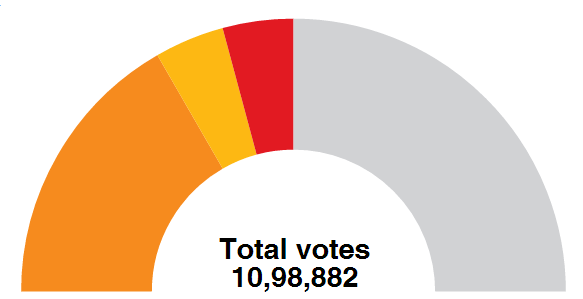Indian Presidential Election 2017 Opinion Poll Predictions Survey Results
- Details
- Category: National Political News
- Last Updated: Tuesday, 04 July 2017 16:03
Indian Presidential 2017 Opinion Poll Elections Predictions Survey Results 
Presidential election 2017 Date
The Presidential election will be held on 17 July 2017. the counting of votes will take place on 20 July 2017. This is five days before President Pranab Mukherjee's terms expires.
Ram Nath Kovind, the governor of Bihar, is the NDA's candidate for the 13th President of India. His name was announced by BJP chief Amit Shah today after a meeting of the parliamentary party - the BJP's highest decision-making body. Mr Kovind will file nomination for President's position on June 23, Mr Shah said. If elected, he will be the second Dalit President after KR Narayanan to hold the nation's highest office.
The president is elected by an electoral college consisting of the elected members of both houses of parliament, the elected members of the Legislative assemblies of the 29 states and the elected members of the legislative assemblies of the Union Territories of Delhi and Puducherry.
The nomination of a candidate for election to the office of the President must be subscribed by at least 50 electors as proposers and 50 electors as seconders. The election is held in accordance with the system of proportional representation by means of the Single transferable vote method. The voting takes place by secret ballot. The manner of election of President is provided by Article 55 of the Constitution.
Indian Presidential Election 2017 Candidates
|
Candidate
|
Ram Nath Kovind | Meira Kumar |
| Party | BJP | INC |
| Alliance | NDA | UPA |
| Home state | Uttar Pradesh | Bihar |
Ram Nath Kovind, the Governor of Bihar, was announced as the Bharatiya Janata Party(BJP)-led NDA's candidate for the post of President of India by BJP president Amit Shah on 19 June 2017. Kovind is a Dalit leader and a politician from the BJP.
Kovind filed his nomination for the election on 23 June 2017. Meira Kumar, the former Speaker of Lok Sabha, was announced as the Indian National Congress(INC)-lead opposition's candidate for the post of President of India, after a meeting held on the 22 June 2017
Presidential Election 2017 Statistics
In India, the President is elected by an electoral college comprising elected members of the Lok Sabha, elected members of the Rajya Sabha, and elected members of the State Legislative Assemblies. The total number of voting MPs in the Lok Sabha and the Rajya Sabha is 776, while the total number of voting MLAs is 4,114.
- Value of an MLA's vote: Total Population of state /number of state MLAs* 1000
- Value of an MPs vote: Value of all MLA votes/ total no of MPs
According to this formula, The vote of each MP is - 708 while the
Vote of an MLA is depends upon population of his state and state assembly strength. For ex,
Vote Value of UP MLA is 208 while that of Sikkim MLA is 7.
Under this system, the candidate fielded by a party or parties will have to secure 50 percent of votes polled (ie: 5,49,441 votes) to win the presidential seat.
Math of Presidential Elections
Total MLAs: 4114
Total MPs: 776
Total MLA Vote Value: 5,49,474
Total MP Vote Value: 5,49,408
Total Vote Value: 10,98,882
The President of India is elected by an electoral college comprising of:
- Elected members of Lok Sabha (543)
- Elected members of Rajya Sabha (233)
- Elected members of State Legislative Assemblies including Delhi and Puducherry (4120)
Indian Presidential Election 2017 Process
The president is elected by an electoral college consisting of the elected members of both houses of parliament, the elected members of the Legislative assemblies of the 29 states and the elected members of the legislative assemblies of the Union Territories of Delhi and Puducherry. As of 2017, the electoral college comprises 776 MPs and 4120 MLAs. The total strength of Electoral college is 10,98,882 votes. Halfway mark is 5,49,442 votes. After state assembly elections and by-polls of 2017, NDA is short of nearly 20,000 votes.
The nomination of a candidate for election to the office of the President must be subscribed by at least 50 electors as proposers and 50 electors as seconders. The election is held in accordance with the system of proportional representation by means of the Single transferable vote method. The voting takes place by secret ballot. The manner of election of President is provided by Article 55 of the Constitution
To push its luck in the 2017 Presidential contest, the BJP needs to fare well in the ongoing elections in five assemblies and early next year’s state polls, besides trying to win them to expand its national footprint.The ruling party falls short of 1.85 lakh votes required to win the prestigious battle that involves an electoral college of 10.98 lakh votes.
In the Presidential election, each MLA vote carries a value proportionate to the population of the state as per the 1971 census. With Uttar Pradesh being the most populous state, an MLA from there has the highest value (403), while a legislator from Mizoram and Arunachal Pradesh has the least value.



